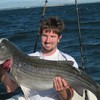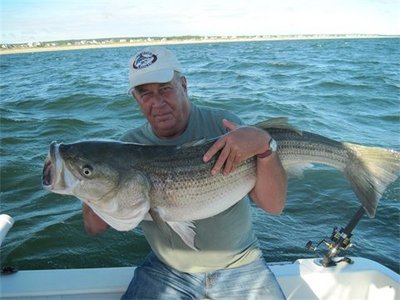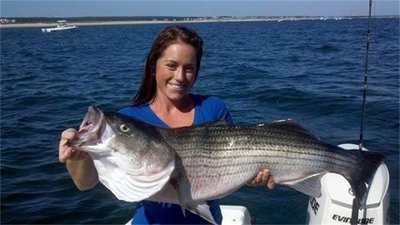This article first appeared in the Sports section of Plymouth patch:
http://plymouth.patch.com/articles/fishing-cape-cod-bay-for-big-striped-bass#photo-6629785
Cape Cod Bay is one of the best places in New England to target large striped bass. The Bay is home to an enormous population of fish heavier than 25 pounds, and produces big bass even during the height of summer, when other locations dry up.
For the most part, Cape Cod Bay is 600 square miles of sandy bottom. There really is not much structure, when compared to the rips of Nantucket Sound or the rocks along the Elizabeth Islands. However the lack of structure certainly does not have a negative impact on the quality of fishing.
Cape Cod Bay, like most spots in our area, fishes differently depending upon the time of the year. With summer right around the corner, certain strategies and techniques will work better than others. Being flexible and having a solid gameplan can help an angler become more efficient on the Bay-leading to more big stripers hitting the deck.
Summertime Techniques
The biomasses of bass that invade Cape Cod Bay during the summer are not always easy to catch. Oftentimes the fish will only hit a very specific offering presented in a very specific fashion. At other times the bass will have lockjaw and be next to impossible to coax into biting. Of course there are those days when the bass are locked and loaded, and will pounce on any lure or bait an angler employs.
The two techniques we use most often aboard the Miss Loretta are trolling tubes and fishing live eels.
Red, orange and black tubes do a solid job of imitating the large sandworms and milky ribbon worms that reside in the Bay's sediment. Not much effort is required to catch a large worm squiggling through the water column. This makes slow trolled tubes effective on aggressive, as well as lethargic striped bass. It is my belief that bass hold a "why not bite that?" attitude towards a properly trolled tube and worm--it is just too easy of a meal to pass up. Check out Understanding Big Bass Behavior to get a better idea of why big bass eat tubes.
My favorite method for fishing live eels is to use a reliable color sonar unit to locate a school of large bass. Upon locating a school, we will quickly pitch three or four eels right into the center of the pack of bass. If the bite is on, pitching eels in this matter will quickly eclipse the the number of fish taken by boats trolling.
On occasion we will also troll live eels on braid and leadcore setups. If the bass are spread out over a large expanse of water, and are holding shallow, we will skip a live eel across the surface. For example, on a trip last summer we located an area holding hundreds if not thousands of large stripers. Even though we were in 80 feet of water, the bass were holding just under the surface. Slow trolling eels on light spinning setups produced some impressive surface strikes unlike anything I had seen before.
If the bass are holding a bit deeper, say at around 25 feet, we will slow troll live eels utilizing leadcore line. After a lot of trial and error, I have found that our hookup ratio is best when the reels are left in gear in the rod holder. However sometimes the bass will miss the hook by nipping at the tail end of the eel, which can prove to be very aggravating. To help in situations like this we will rig the live eel with two hooks. This can be difficult yet it is not impossible and can yield a significant improvement in hookup ratio. Check out Live Eel Fishing 101 for diagrams on how to rig an eel with a tail hook.
Finding the Biomass
A mistake many rookie anglers make when fishing the Bay is to troll around aimlessly for hours, hoping to encounter a nice bass or two. I used to do this myself, and caught enough fish for it to seem like I knew what I was doing. At the time I did not realize just how much I was restricting my angling success.
Spending more time searching the Bay for its constantly moving biomass of stripers has now become the cornerstone of our fishing trips. Having a reliable color sonar unit onboard is critical to achieving a consistent level of success in Cape Cod Bay.
A typical trip will find us beginning our search somewhere off the coast of Sandwich or Barnstable. We will cruise at around 10 knots, keeping a keen eye on the sonar. If we see even just one orange blotch (which is what a bass looks like on my unit) we stop our search and begin fishing.
Marking just one fish may not seem like that big of a deal, however Cape Cod Bay is a vast expanse of water. Running your boat over even just one bass is a remarkable feat if you think about it. More often than not, that one bass is but one of hundreds of fish spread out in the immediate area.
It is not unusual for us to begin marking fish quickly after departing the dock. It is also not unusual for us to cover 20 plus miles, and spend five or more hours searching the Bay until we locate a spot worthy of fishing. We had numerous trips in 2010 when we did not drop a line in the water for the first few hours of the trip. Then finally, after covering many miles of open water, we would locate a concentration of nice fish and quickly load up the boat.
Give Developing a Strategy for Finding Big Fish a read to learn more about how to locate striped bass in Cape Cod Bay.
Things can change quickly in Cape Cod Bay!
Happening Right Now
As June flows into July the bass will begin to settle into their deeper haunts. During this part of the season we most often find large concentrations of bass in water ranging in depth from 50-90 feet. The bass are most often suspended in the middle to upper ranges of the water column.
Covering a lot of water will become even more important as July approaches. Keep in mind that it is not all that unusual to cover miles of open water before finding an area worthy of wetting a line.
Tight lines and good luck!




